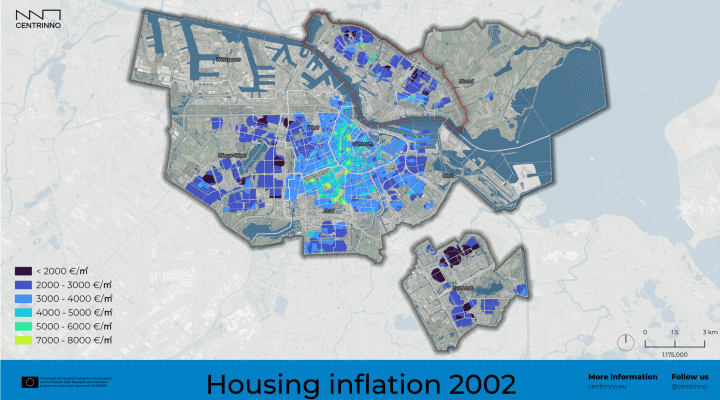AMSTERDAM
Local craftsmanship in a rapidly transforming area

About the pilot area
AMSTERDAM NOORD
Historically known for shipbuilding and repair, the neighbourhood of Amsterdam Noord has emerged as a rapidly transforming hub for circular activities and innovation. Despite its industrial nature, the neighbourhood maintains 7.6% green space share, with a population density of 1,778 people per square kilometer, accommodating a diverse mix of communities and industries. The heritage status of certain parts of the neighbourhood such as Buiksloterham and the NDSM-werf bridges the gap between industrial history and a sustainable future.
Buiksloterham, as one of the last industrially utilized areas in Noord, acts as an inner-city production center and an important neighbourhood for closing the loop on urban waste streams through remanufacturing, recovery and recycling.

However the pressing need for housing in the Amsterdam area has led to the conversion of remaining industrial land into residential use, presenting the neighborhood with challenges such as the termination of rental contracts for small business and makers in the area. Additionally, the neighborhood faces other issues including the low availability of green spaces, industrial pollution and gentrification.
For the CENTRINNO Cartography, WAAG, Pakhuis de Zwijger and HMC (the local wood and furtniture college) have set out to portrait local makers and highlight their contribution towards local circularity. The goal of Amsterdam’s Cartography is to become an integral part of Maakschap Amsterdam - a lobbying forum for Amsterdam’s makers developed throughout the project. Maakschap Amsterdam has the mission to communicate to local policy makers why makers are needed to achieve the city’s circular economy goals.
FOLLOW AMSTERDAM'S CARTOGRAPHY JOURNEY
Which insights have been gathered by our local context detectives?
Read through our gallery of local anecdotes, research findings and in-depth analysis
Parallel to Amsterdam’s efforts to understand city and neighbourhood-wide urban challenges, the team has embarked on a journey to get to know the local maker community, their resources and concerns
Who was mapped
Craftspeople
Businesses in repair and remanufacture
Why?
-
To build a sense of trust with local stakeholders
-
To understand the challenges of local makers with respect to urban development
-
To identify existing circular makers and potential new connections
-
To map the disappearance of makers in the future
How was it useful for the Amsterdam pilot team?
-
Created maps that could be used in public discussions with policy makers
-
Embedded maps on Maakschap Amsterdam - a platform that unites makers to lobby for inclusive policy making
The mapping of makers in Noord was done by a dedicated team member who used an interview guide in informal conversations with makers
What local resources were mapped?
Waste streams
Tools & equipment
Knowledge
What else was asked?
-
Length and renewal status of current rental contracts
-
Space requirements
-
Existing involvement in Circular Economy initiatives
How was data collected?
-
In-person informal interviews, collected by a dedicated team member during two summers
Lessons learned
-
A dedicated mapping champion who can engage in direct conversations with individuals facilitates the process
-
The cartography made the large set of data easy to visualize and share with stakeholders
-
The visual representation helps to communicate the story effectively and engage with the community
Which circular opportunities were identified or explored for further research?
-
Space sharing - The pilot identified other existing development initiatives that work as a community-based land trust to lock in land for circular makers and community project. Together, they have explored the opportunity of a sharing model for tools, space and infrastructure for local productive businesses.
-
Open Workshops - The pilot engaged local studios and workshops across Amsterdam Noord in regular open evenings to bring more visibility to makers and their value for urban life.
-
Circular Neighbourhood Show - Engagement of local schools in which students designed circular products
-
Makers of Noord Exhibition - Neighbourhood portraits of local (circular) makers to increase visibility of makers in Noord
-
Connecting policy makers with makers - During the final year of CENTRINNO, Maakschaap Amsterdam has become an active alliance in which makers unite to lobby for better policy making for makers in Amsterdam. Read one maker's emotional plea for spaces for makers on the CENTRINNO Living Archive

GALLERY
 |  |  |
|---|---|---|
 |  |  |

